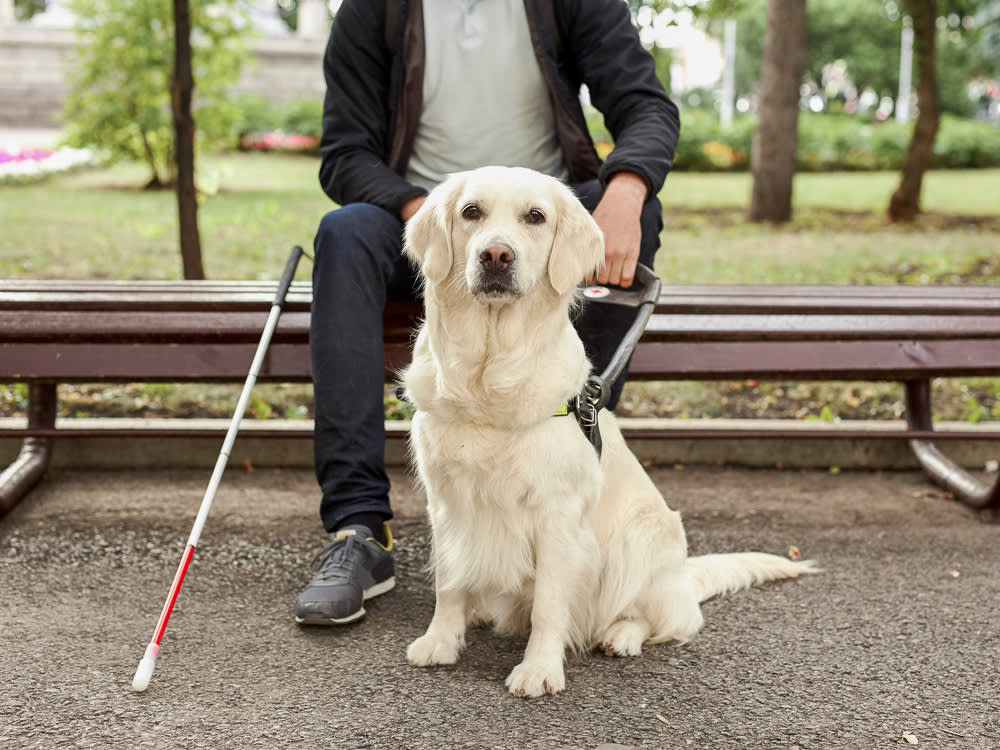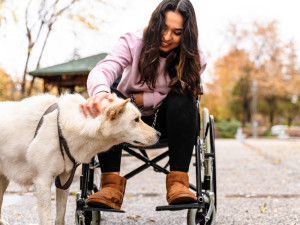What is the Difference Between Service Dogs and Therapy Dogs?
Both are perfect angels, to be clear.
In This Article:
What Is a Service Dog? What Is a Therapy Dog? Service Dog vs. Therapy Dog How to Qualify My Dog To Be a Therapy Dog What About Emotional Support Animals? Frequently Asked Questions
Dogs make our lives better every day, whether they are giving cuddles, encouraging us to get outside, or making us laugh with their goofy antics. Hundreds of thousands of dogs in the United States make life better formally, as therapy and service dogs who work to provide comfort and support to those in need.
So, what exactly is the difference between service dogs and therapy dogs? Essentially, service dogs are specifically trained to perform a disability-related task for an individual. Therapy dogs, on the other hand, provide comfort and support to a variety of people in hospitals, schools, nursing homes, and other settings.
What is a service dog?
The Americans with Disabilities Act (ADA) definesopens in new tab service dogs as dogs that are individually trained to do work or perform tasks for people with disabilities. They are considered to be medical equipment, no different than, say, a wheelchair or insulin pump.
How much do you spend on your pet per year?
“They perform tasks like they guide somebody who’s visually impaired, they might detect seizures, help with mobility, things like that,” says Camille Ward, certified applied animal behaviorist, PhD, and founder of behavior consulting company About Dogs LLCopens in new tab. “It’s highly specialized training that these dogs go through to learn specific skills to meet the needs of an individual that they’re working with.”
Years ago, most people were familiar with only service dogs for the blind and service dogs for the deaf. Today, service dogs work with people with many disabilities, including mental illnesses, autism, seizures, diabetes, and other conditions that affect the person’s capacity to perform at least one major life task. The dog’s purpose is to help the person be more independent.
Examples of common service dog tasks include:
Alerting and protecting a person who is having a seizure
Reminding a person to take prescribed medications
Pulling a wheelchair
Calming a person with post-traumatic stress disorder (PTSD) during an anxiety attack
Guiding people who are blind
Alerting people who are deaf
A person with a disability may be matched with a service dog who has been trained to assist with the disability they have. They may also choose to train their dog to become a service dog by developing a training regime that meets their specific needs.
What is a therapy dog?
Therapy dogs have very different jobs. Unlike service dogs, who complete specific tasks for specific people, therapy dogs provide psychological or physiological support to a variety of people in a variety of settings. They usually have stable temperaments and friendly personalities.
Common places where therapy dogs may volunteer include:
Hospitals
Schools
Nursing homes
Daycares
Group homes
Rehabilitation centers
Service dogs vs. therapy dogs
It can be easy to confuse different types of “working” dogs. They may be wearing a vest that identifies them as a service dog or therapy dog, or they may just look like a typical dog, because neither are legally required to wear identification. Plus, many different breeds can be therapy dogs and service dogs.
Aside from having different purposes, service dogs and therapy dogs have different training regimes, certifications, laws protecting them, and rules regarding interaction. Here are some of the major ones:
You can pet a therapy dog, but not a service dog
You should not pet a service dog, because they are working to assist an individual with a disability and should not be distracted. Petting them could take their focus away from their task at hand. “Service dogs, it’s really hard because they’re cute, people want to go up to them and pet them, but that’s not what they’re for,” Ward says.
Therapy dogs, on the other hand, are usually meant to be touched. Because therapy dogs provide general support for many different people, not just a specific individual, you are usually safe to pet them, especially if you are at a facility or event that is promoting therapy dogs. When in doubt, you can always ask the dog’s parent or handler.
Services dogs are protected by the ADA, while therapy dogs are not
Under the ADA, service dogs are allowed to accompany their person in most public places, such as restaurants, stores, and other businesses. This includes establishments that prepare and serve food whose state or local health codes prohibit animals. When a service dog accompanies someone to a restaurant or other facility, staff can ask only two questions: “Is the dog a service animal because of a disability?” and “What work or tasks is the dog trained to perform?” They may not ask about the person’s disability or require documentation.
The ADA does not protect therapy dogs, because they are not specifically trained to work with someone with a disability. However, these dogs’ status as therapy dogs may grant them access to facilities that otherwise do not allow pets, such as schools.
Service dogs are assigned to individuals, while therapy dogs work with a variety of people
Service dogs provide services for individuals; they are specifically trained to help an individual with disability related tasks. Therapy dogs provide support for a vast array of people. Their form of assistance is more general, including providing comfort and cuddles.
Certification and training requirements are complicated for both service and therapy dogs
The ADA does not require service dogs to go through a specific certification or training regime. This may be because they do a variety of different service-related tasks, depending on the disability of the person they are assisting. That being said, many service dogs go through extensive individualized training programs and can be formally registered.
Similarly, there is no federal law stating that therapy dogs must be certified, but many are. This may be because certain education and therapeutic environments refuse to work with uncertified therapy dogs for liability reasons. The Alliance of Therapy Dogsopens in new tab and Pet Partnersopens in new tab offer popular therapy dog certification programs.
How to qualify my dog to be a therapy dog
So, you may be wondering, does my dog have what it takes to be a therapy dog? In most therapy dog certification programs, potential candidates must meet the following base requirements:
Dogs must be at least one year old.
They must have a calm disposition and welcome attention from strangers.
Dogs must be attentive to their handler.
If a dog meets these requirements, they may be able to proceed with a certification program, which vary in evaluation and training steps.
Chloe Escamilla of Cincinnati, Ohio, decided to certify her two-and-a-half-year-old Portuguese Water Dog, Louie, so he could accompany her as a therapy dog at her practice, Balance Psychotherapyopens in new tab. She registered Louie through the Alliance of Therapy Dogs opens in new tab in a process that involved a three-part-test: one skills and obedience assessment and two assessments at a nursing home.
“They just had to make sure he wouldn’t bark, jump, or be scared of wheelchairs,” Escamilla says.
When he accompanies Escamilla to work, Louie also has liability insurance. Different facilities and organizations that host therapy dogs may require that they hold certain certifications or, potentially, insurance coverage. Because certification and training requirements vary by where you live and where you plan to take your therapy dog, it is important to do your own research on specific requirements.
What about emotional support animals?
Emotional support animals are another type of support pet. An emotional support animal (ESA) is defined as a pet who emotionally supports their parent. Under the Fair Housing Act (FHA), ESAs can live in no-pets-allowed housing. Until January 2021, they were also allowed to fly in the cabin of an aircraft free of charge. But due to some incidents by people claiming that certain pets were emotional support animals, from llamas to peacocks, airlines now offer free, unconfined rides only to service dogs, including psychiatric service dogs who support people with mental disabilities, such as anxiety.
FAQs
Can I pet a therapy dog?
Because therapy dogs are meant to provide comfort and support to a variety of people in a variety of settings, they are usually safe to pet.
Can I pet a service dog?
You should not pet a service dog because they are working to assist a person with a disability and should not be distracted.
Do service dogs or therapy dogs have to wear vests?
Neither service dogs nor therapy dogs are legally required to wear vests or identification.
References
Dogs, Alliance of Therapy. “Difference between a Therapy Dog vs a Service Dog.” Alliance of Therapy Dogs Inc., 12 Mar. 2017, www.therapydogs.com/service-dog-vs-therapy-dog/opens in new tab.
Nick. “Therapy and Service Dog Vest | Help Identify Your Working Dog.” US Service Animals Blog, 2 July 2019, usserviceanimals.org/blog/therapy-dog-vest/opens in new tab.
U.S. Department of Justice Civil Rights Division. “ADA Requirements: Service Animals.” ADA.gov, 28 Feb. 2020, www.ada.gov/resources/service-animals-2010-requirements/opens in new tab.












